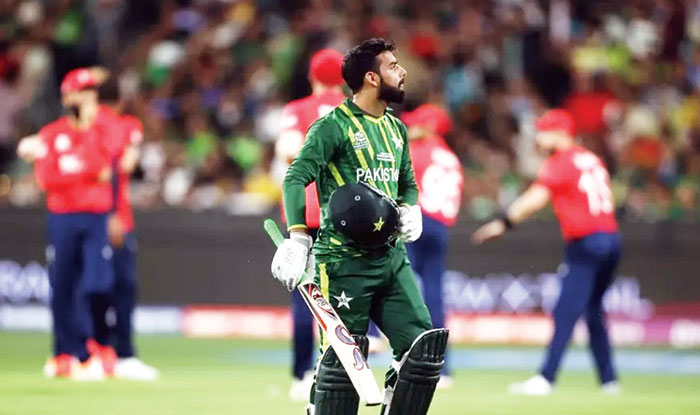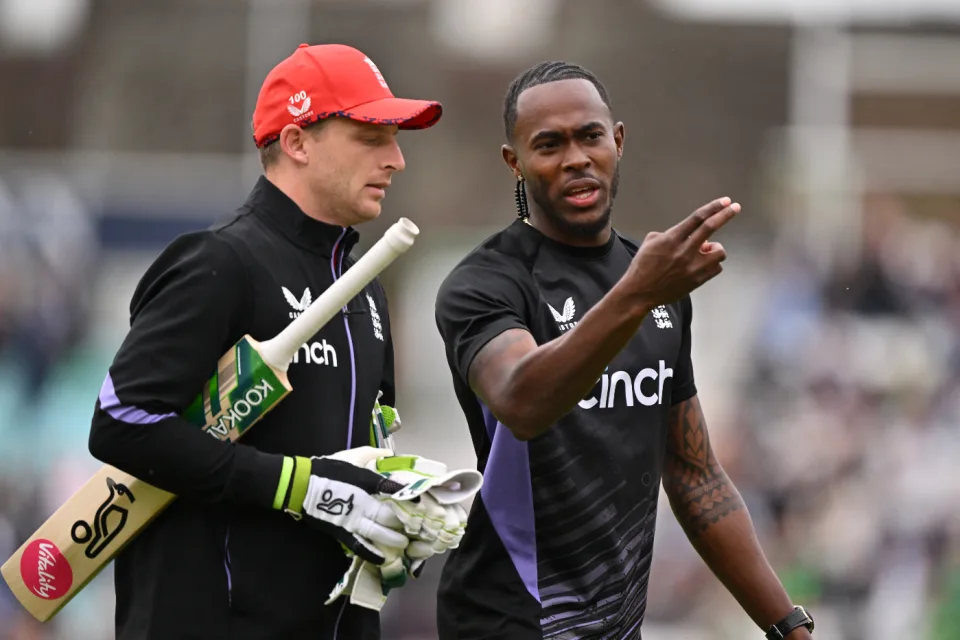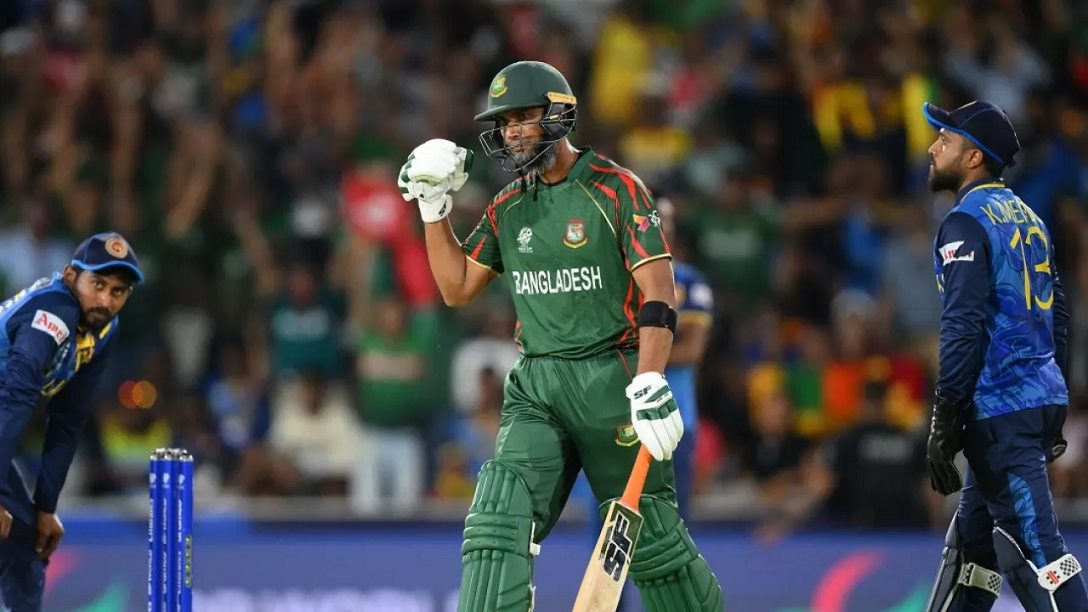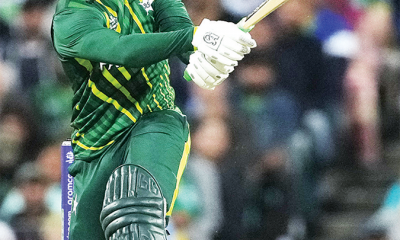Sports
Stephen Fleming: Pakistan made a ‘massive mistake’ in the death overs

Pakistan were 119 for 4 after 16 overs in the T20 World Cup final against England at the MCG but managed to score only 18 for the loss of four wickets in the last four overs, and their approach at the death was a “massive mistake” according to former New Zealand captain and current Chennai Super Kings coach Stephen Fleming.
“[Pakistan were] 121 [119] for 4 in 16 overs. There’s enough in that wicket to suggest that a 165-score is going to be a real good challenge,” Fleming said on ESPNcricinfo’s T20 Time Out show. “There was inconsistent bounce, there was a little bit of movement on offer and it was turning.
“So as a unit, you should be saying that ‘we’ve got some artillery here, we know that we just need to get a score on the board and we will be competitive’. The fact that the last four overs went for 16 [18] runs, I think that’s a massive mistake.”
“Even at 10 [runs per over], you get to 161 and if you have one good over, you get to 165 which I think is more than competitive given what we have seen,” Fleming said. “Especially given the turn, which was unexpected, and the little bit that’s on offer for probably a quicker and more skilful pace attack. So yeah, there was a lot going on up to that point, but Pakistan missed a massive trick.”
Fleming said that Pakistan did not read the ground dimensions and conditions well. “Teams often go to the MCG and they think traditionally, we’ll get to 16 overs and then we’ll whack ourselves 15 runs an over and we’ll get a great score. The MCG is not that ground. If there’s any research that should have been done is on how to finish off an innings.”
Pakistan’s last three recognised batters – Shan Masood, Shadab Khan and Mohammad Nawaz – were all caught attempting the big hits at the MCG. “The ones and twos that were so good all the way through the innings, they disappeared and all of a sudden they were just trying to hit it out of the ground over 85 metre boundaries,” Fleming said. “And that just doesn’t work. Livingstone’s there, just picking it off. Sorry, I reckon it just wasn’t smart and it could cost them, the score of 165 was easily there.”
Former Australia allrounder Tom Moody said that Masood, who scored 38 off 28 in the final, laid down the right template with his running between the wickets.
“We saw Shan Masood show the way to how to score runs at the MCG. His running between the wickets was superb, the twos that he ran, the pressure he put on the outfield, that didn’t really need to change,” Moody said, adding that Babar Azam’s dismissal was the turning point in Pakistan’s innings.
“I think it was in the 12th over Babar was dismissed, and from then onwards, it just went south where they just seemed to lose sight of how to accumulate runs and get to that 160-165 that Flem’s [Fleming] talking about,” Moody said. “In a total of 120 balls, if you’re scoring six fours and two sixes [Pakistan scored eight fours and two sixes], I think that shows more than anything that no one else really got in on that surface to be able to in those last four overs pick off a few boundaries.
“It was a pretty disappointing finish from Pakistan, they should be more than what they got and it’s really down to some poor management with their batting in the back 10 overs.”
Former India captain and head coach Anil Kumble said Masood’s dismissal put the pressure back on Pakistan. “I think, like Flem [Fleming] mentioned, they were probably thinking boundaries and sixes and that’s what you are sort of tuned to in the last four overs. I think Shan Masood getting out at that time certainly put the pressure back on Pakistan, because he was someone who looked comfortable and he was in control of his scoring,” Kumble said.
that’s what you are sort of tuned to in the last four overs. I think Shan Masood getting out at that time certainly put the pressure back on Pakistan, because he was someone who looked comfortable and he was in control of his scoring,” Kumble said.
“And that’s something I didn’t see in even Babar, even though Babar batted well till he got out. Shan Masood looked in better control of the proceedings, in terms of how he wanted to manoeuvre the bowling.
(cricinfo)
Sports
England face Australia in the battle of champions

The first truly heavyweight clash of this expanded T20 World Cup format comes freighted with both history and subplots. A rematch of the 2010 World T20 final at Kensington Oval, the match pits Jos Buttler’s defending champions – who are aiming to become the first team to retain the trophy – against the Australian winning machine, victors at the 2021 edition and current world title-holders in Test and ODI cricket. And that’s before you throw in the Ashes for afters.
Already there is added pressure on England, after the rain in Bridgetown led to a share of the points in their opener against Scotland (and that having conceded 90 runs from 10 overs without taking a wicket in a tepid bowling display). Lose to their oldest rivals and it will leave their Super 8 prospects open to being waylaid by the perils of net run-rate calculations, or worse.
The Scotland match was the third abandonment in five suffered by England, after a rain-affected home series against Pakistan, which has clearly hampered their readiness for this campaign after almost six months without playing T20 together. It does not take much for a side to click in this format – and England looked in decent shape when they did get on the field against Pakistan – but Buttler will be anxious for things to go their way on Saturday, if only to avoid further questions referencing the team’s disastrous ODI World Cup defence last year.
Australia, under the laidback leadership of Mitchell Marsh would love nothing more than to add to the English sense of jeopardy – having helped bundle them out of the tournament in India on the way to taking the crown. Their head to head record is less impressive in T20 however, with England having won six of the last seven completed encounters, as well as that 2010 final.
Despite a wobble with the bat, Australia avoided mishap against Oman earlier in the week, the experience of David Warner and Marcus Stoinis shining through in difficult batting conditions. Surfaces in the Caribbean – not to mention those games staged in the USA – have already had teams scratching their heads; rather than the “slug-fest” England had prepared for, following a high-scoring tour of the Caribbean in December, it looks as if boxing smart may be the way to go.
Speaking of Warner, this could be the last time he faces up against England in national colours – and another match-winning contribution would likely reduce the chances of them meeting again in the knockouts. On the other side of the card is Jofra Archer, fresh from an emotional maiden outing at Kensington Oval and ready to take on Australia for the first time in any format since 2020. Can Mark Wood fire up England’s campaign, as he did during last summer’s Ashes? Will Pat Cummins be back to harass the old enemy once again? Seconds out, it’s almost time to rumble.
Cummins is set to return after being rested for the Oman game, which saw Mitchell Starc leave the field with cramp. Starc is understood to be fine and could keep his place – which would likely see Nathan Ellis miss out. Marsh is still not fit to bowl, with Australia likely to continue with the allrounder combination of Stoinis and Maxwell to give them cover.
Australia (probable XI): David Warner, Travis Head, Mitchell Marsh (capt), Glenn Maxwell, Marcus Stoinis, Josh Inglis (wk), Tim David, Pat Cummins, Nathan Ellis/Mitchell Starc, Adam Zampa, Josh Hazlewood
The one change England may consider is Reece Topley coming in for Wood, with the expectation that there will be some rotation among the seamers through the course of the tournament.
England (probable XI): Phil Salt, Jos Buttler (capt & wk), Will Jacks, Jonny Bairstow, Harry Brook, Liam Livingstone, Moeen Ali, Chris Jordan, Jofra Archer, Adil Rashid, Reece Topley/Mark Wood
[Cricinfo]
Sports
South Africa up against their bogey team in batter-unfriendly New York

Once is coincidence, twice is a clue, and three times is proof.
To paraphrase Agatha Christie, that is the narrative around South Africa’s meeting with Netherlands at this T20 World Cup.
The Dutch beat South Africa at the 2022 tournament and ended their semi-final hopes in a match where South Africa appeared to be sleep walking, and then beat them again at the 2023 ODI World Cup, where they exposed South Africa’s vulnerability in the chase. If they to do the treble, not only will Netherlands take the lead in Group D, but they will offer conclusive evidence of the threat they pose to Full Members, especially South Africa.
Of course, it will take some doing after South Africa’s opening performance against Sri Lanka, where they reduced their opposition to their lowest T20I total and chased it down in fairly straightforward fashion thanks to the most stable middle-order of their white-ball era. In Aiden Markram, Tristan Stubbs, Heinrich Klaasen and David Miller, South Africa have bankers and big-hitters and, for this match, they also have the advantage of experience. They’ve already played at Eisenhower Park, and have first-hand knowledge that run-scoring doesn’t come easily;Klassen said they are prepared to use their “cricket brains” and play “smarter cricket”.
But the conditions could be good news for Netherlands, who are not naturally a line-up of big hitters and build their innings on a foundation of turning ones into twos. In other words, they tend to take a slightly more conservative approach to batting, which may work well here, but they’ll be wary of the uneven bounce of the surface and will have to come up with plans to counterattack especially against South Africa’s seamers. Their own bowlers were exemplary in Dallas and will look to build on that performance against a line-up that will likely be more proactive than Nepal’s, but who they have managed to keep quiet not once, but twice in the past. Third time’s the charm, they say.
Anrich Nortje’s stunning return to form against Sri Lanka means South Africa may not have to tinker with the bowling combination, and Gerald Coetzee and Tabraiz Shamsi may have to wait their turns to get a game. The batting line-up should be unchanged, with no space for Ryan Rickelton yet.
South Africa: Quinton de Kock (wk), Reeza Hendricks, Aiden Markam, Tristan Stubbs, Heinrich Klaasen (wk), David Miller, Marco Jansen, Keshav Maharaj, Kagiso Rabada, Ottneil Baartman, Anrich Nortje
Conditions in New York may tempt Netherlands to include an extra seamer and they have Kyle Klein in their squad. But it could come at the expense of a shortened batting line-up and they may not want to risk that.
Netherlands: Michael Levitt, Max O’Dowd, Vikramjit Singh, Sybrand Engelbrecht, Scott Edwards (capt, wk), Bas de Leede, Teja Nidamanuru, Logan van Beek, Tim Pringle, Paul van Meekeren, Vivian Kingma
[Cricinfo]
Latest News
Mustafizur, Rishad, Hridoy dazzle in Bangladesh’s tight two-wicket win over Sri Lanka

Nuwan Thushara’s last over brought Sri Lanka screaming back into the match,as he first bowled Rishad Hossain, and then nailed Taskin Ahmed in front of the stumps with a pinpoint swinging yorker. This left Bangladesh eight wickets down, with 12 runs still to get.
However, the experienced Mahmudullah was at the crease for Bangladesh, and despite some further nervy moments, pushed Bangladesh across the line off the last ball of the 19th over.
But this was a match chiefly decided by Bangladesh’s own outstanding bowling. Mustafizur Rahman was the best among them, using shorter lengths and his cutters efficiently, to claim figures of 3 for 17. Rishad Hossain’s three-for through the middle overs also kept Sri Lanka quiet.
Mustafizur was instrumental in Sri Lanka’s downward spiral through the middle overs, which culminated in a crash-and-burn end. Ultimately, their inability to find boundaries, or even rotate strike against good Bangladesh bowling resulted in their downfall. A score of 125 for 9 always seemed poor on a decent pitch, even if their bowlers made a match of it in the end.
Brief scores:
Bangladesh 125 for 8 in 19 overs (Towhid Hridoy 40, Litton Das 36; Dhanajaya de Silva 1-11, Nuwan Thushara 4-18, Wanidu Hasaranga 2-32, Matheesha Pathirana 1-27) beat Sri Lanka124 for 9 in 20 overs (Pathum Nissanka 47, Dhananjaya de Silva 21; Tanzim Hasan Sakib 1-24, Taskin Ahmed 2-25, Mustafizur Rahman 3-17, Rishad Hossain 3-22) by two wickets
[Cricinfo]
















